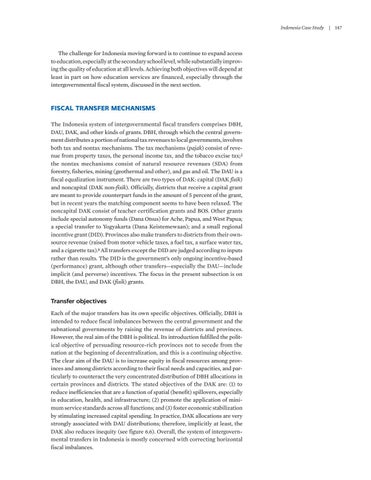Indonesia Case Study | 147
The challenge for Indonesia moving forward is to continue to expand access to education, especially at the secondary school level, while substantially improving the quality of education at all levels. Achieving both objectives will depend at least in part on how education services are financed, especially through the intergovernmental fiscal system, discussed in the next section.
FISCAL TRANSFER MECHANISMS The Indonesia system of intergovernmental fiscal transfers comprises DBH, DAU, DAK, and other kinds of grants. DBH, through which the central government distributes a portion of national tax revenues to local governments, involves both tax and nontax mechanisms. The tax mechanisms (pajak) consist of revenue from property taxes, the personal income tax, and the tobacco excise tax;3 the nontax mechanisms consist of natural resource revenues (SDA) from forestry, fisheries, mining (geothermal and other), and gas and oil. The DAU is a fiscal equalization instrument. There are two types of DAK: capital (DAK fisik) and noncapital (DAK non-fisik). Officially, districts that receive a capital grant are meant to provide counterpart funds in the amount of 5 percent of the grant, but in recent years the matching component seems to have been relaxed. The noncapital DAK consist of teacher certification grants and BOS. Other grants include special autonomy funds (Dana Otsus) for Ache, Papua, and West Papua; a special transfer to Yogyakarta (Dana Keistemewaan); and a small regional incentive grant (DID). Provinces also make transfers to districts from their ownsource revenue (raised from motor vehicle taxes, a fuel tax, a surface water tax, and a cigarette tax).4 All transfers except the DID are judged according to inputs rather than results. The DID is the government’s only ongoing incentive-based (performance) grant, although other transfers—especially the DAU—include implicit (and perverse) incentives. The focus in the present subsection is on DBH, the DAU, and DAK (fisik) grants.
Transfer objectives Each of the major transfers has its own specific objectives. Officially, DBH is intended to reduce fiscal imbalances between the central government and the subnational governments by raising the revenue of districts and provinces. However, the real aim of the DBH is political. Its introduction fulfilled the political objective of persuading resource-rich provinces not to secede from the nation at the beginning of decentralization, and this is a continuing objective. The clear aim of the DAU is to increase equity in fiscal resources among provinces and among districts according to their fiscal needs and capacities, and particularly to counteract the very concentrated distribution of DBH allocations in certain provinces and districts. The stated objectives of the DAK are: (1) to reduce inefficiencies that are a function of spatial (benefit) spillovers, especially in education, health, and infrastructure; (2) promote the application of minimum service standards across all functions; and (3) foster economic stabilization by stimulating increased capital spending. In practice, DAK allocations are very strongly associated with DAU distributions; therefore, implicitly at least, the DAK also reduces inequity (see figure 6.6). Overall, the system of intergovernmental transfers in Indonesia is mostly concerned with correcting horizontal fiscal imbalances.






